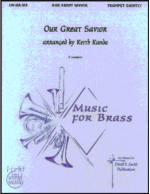-
-
Since By Man Came Death
$15.002 tpts, horn, 2 tbns, opt. tuba (tpt. sub. for horn) MESSIAH FOR BRASS SERIES
-
-
-
Risen in Victory (Medley: The Strife Is O’er, Thine Is the Glory)
$16.002 tpts, horn, 1 tbn, 1 tbn or tuba (tpt sub. for horn)
-
-
-
-
-
-
-
-
-
-
-
-
-
Guide Me, O Thou Great Jehovah
$16.002 tpts, horn, tbn, tuba (tpt sub. for horn, tbn sub. for tuba)
-
The Greatness of the Lord (Medley: Great Is the Lord, Great Is Thy Faithfulness)
$18.002 tpts, horn, tbn, tbn/tuba (tpt sub. for horn)
-
-
Glory Bound (Medley: When We All Get to Heaven, I’ll Fly Away, When the Roll Is Called)
$16.002 tpts, horn, tbn, tbm/tuba (tpt sub. for horn)
-
-
-

